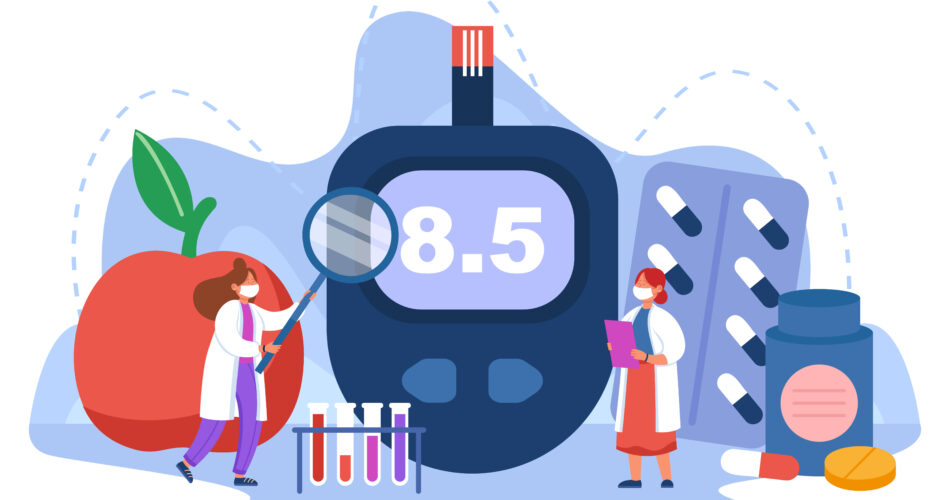One of the struggles of women in pregnancy is the interference of possible conditions with their health and babies’ health. Unfortunately, some of the health risks can happen like overt diabetes mellitus. Once a pregnant woman is diagnosed with this condition, it is important to address it immediately.
Take note that overt diabetes mellitus meets the diagnostic threshold of diabetes in non-pregnant adults, and can have significant implications for pregnancy outcomes if not properly managed. So it is a health complication that can involve aggressive management, which means a guidance from a diabetes doctor is a must.
Don’t worry as this blog can provide a comprehensive guide for a better understanding of the condition. Explore the impact of overt diabetes on pregnancy, the signs and symptoms to watch out for, the diagnostic procedures, and the importance of early diagnosis and aggressive management. Let’s begin!
Understanding Overt Diabetes Mellitus in Pregnancy

Overt diabetes in pregnancy refers to the presence of hyperglycemia that is first recognized during pregnancy and meets the diagnostic threshold of diabetes in non-pregnant adults. This condition is different from gestational diabetes mellitus (GDM), which is characterized by high blood glucose levels that develop during pregnancy and typically resolve after childbirth.
In women with overt diabetes, plasma glucose levels are consistently elevated throughout pregnancy. This can have significant implications for both the mother and the baby. Pregnant women with overt diabetes are at a higher risk for adverse pregnancy outcomes compared to those with GDM. They may also require more aggressive management to maintain optimal glycemic control and minimize the risk of complications.
In that case, it is important for the patients to be well aware of the intervention steps to ensure a safe trimester until their delivery.Regular screening and monitoring are necessary to identify women at risk and provide timely intervention.
Impact of Overt Diabetes on Pregnancy
As mentioned, overt diabetes mellitus can significantly impact pregnancy outcomes for both the mother and the baby. For the mother, this may include a higher incidence of complications such as chronic hypertension and cardiovascular diseases.
On the other hand, the baby is also at risk of adverse fetal outcomes, such as fetal macrosomia and metabolic syndrome, due to the maternal condition. During the first trimester, the baby’s development occurs, which is why if the mother’s glucose is high, potential birth defects can happen.
It is crucial for healthcare providers to recognize the clinical characteristics of overt diabetes early on to ensure prompt initiation of appropriate management strategies. By monitoring blood sugar levels and implementing a tailored treatment plan, the impact of overt diabetes on pregnancy can be minimized, leading to better health outcomes for both the mother and the baby.
Signs and Symptoms of Overt Diabetes in Pregnant Women
Recognizing the signs and symptoms of overt diabetes in pregnant women is essential for early detection and timely intervention. While some women may experience noticeable symptoms, others may not exhibit any obvious signs.
Here are some of the common indicators to watch out:
- High blood glucose levels (gestational diabetes)
- Excessive thirst (polydipsia)
- Frequent urination (polyuria)
- Fatigue and tiredness
- Blurred vision
- Increased hunger
These symptoms may be similar to those experienced in non-pregnant individuals with diabetes. Additionally, the gestational age of the pregnancy may also play a role in the manifestation of overt diabetes symptoms. If any of these symptoms persist, it is important to seek immediate consultation with a doctor for the welfare of your baby and yourself.
Diagnostic Procedures for Overt Diabetes During Pregnancy

Consultation with a doctor is important to address the concerns from overt diabetes mellitus. Diagnostic criteria for overt diabetes in pregnancy include fasting plasma glucose levels, oral glucose tolerance test results, and HbA1c levels. It is important to follow the recommended diagnostic guidelines for proper intervention.
During the session, the healthcare professionals may recommend an oral glucose tolerance test (OGTT) for women at risk, especially during early pregnancy. The OGTT involves consuming a sugary drink and measuring blood glucose levels at specific intervals. Elevated blood glucose levels during the test may indicate the presence of overt diabetes.
Aside from that, diagnostic testing also involved blood sugar testing for monitoring. One common method is self-monitoring of blood glucose levels using a glucose meter. This involves pricking the finger to obtain a small blood sample, which is then placed on a test strip and inserted into the glucose meter for analysis.
Understanding the Results
Understanding the results of blood sugar testing is essential for managing overt diabetes during pregnancy. According to the International Association of Diabetes, the diagnostic criteria for diabetes during pregnancy include the following:
- Fasting plasma glucose level ≥ 126 mg/dL (7.0 mmol/L)
- 2-hour plasma glucose level ≥ 200 mg/dL (11.1 mmol/L) during an oral glucose tolerance test
- Random plasma glucose level ≥ 200 mg/dL (11.1 mmol/L) in the presence of symptoms
These values indicate the presence of hyperglycemia and help healthcare professionals to come up with an accurate diagnosis.
Once the tests confirm overt diabetes mellitus, healthcare professionals will work closely with the pregnant woman to develop a personalized treatment plan that may include dietary modifications, physical activity, and insulin therapy if necessary. Regular monitoring and follow-up visits are essential to track progress and make any necessary adjustments to the treatment plan.
Managing Overt Diabetes During Pregnancy
Managing overt diabetes during pregnancy requires a comprehensive approach. The goal is to achieve and maintain glycemic control to minimize the risk of adverse pregnancy outcomes and postpartum diabetes.
Let’s discuss some of the effective management options for overt diabetes mellitus below!

Nutritional Management and Diet Control
When it comes to managing threats from overt diabetes in pregnancy, it is important to consider a balanced diet. This nutritional management allows patients to be in control of their health through choosing food items that can maintain stable blood glucose levels. It can be challenging to do on your own, but through diet therapy, you can get a proper list of such food suitable for your condition.
A registered nutritionist may provide a diet plan that involves monitoring carbohydrate intake, distributing carbohydrate intake throughout the day, and incorporating foods with a low glycemic index. It’s best to follow this plan carefully for better results.
Maintaining a healthy body weight is also important for managing overt diabetes during pregnancy. Women with overt diabetes and a higher body mass index (BMI) may benefit from weight management strategies, such as portion control and regular physical activity, to help achieve glycemic control.
Physical Activity Recommendations
Meanwhile, physical activity is an important component of managing overt diabetes mellitus during pregnancy. Regular exercise can help improve insulin sensitivity, promote weight control, and contribute to overall health and well-being.
Although, not all types of physical activities are suitable for pregnant patients. Healthcare professionals may recommend specific physical activity guidelines for women with overt diabetes, taking into account individual factors such as gestational age, overall health, and any pregnancy complications. These guidelines may include recommendations for both aerobic exercise and strength training.
Medication and Insulin Therapy
Lastly, medication and insulin therapy may be necessary for managing overt diabetes during pregnancy. Insulin therapy is the preferred treatment for women with overt diabetes, as it does not cross the placenta. It has shown to be safe for both mother and baby.
Prompt initiation of insulin therapy is crucial for achieving and maintaining glycemic control. Insulin may be administered through injections or an insulin pump, and the dosage will be determined based on blood glucose monitoring results and individual needs. It is important to work closely with their doctor for proper administration of the medication.
Monitoring and Follow-up

Regular Check-ups and Ultrasound Scans
Regular check-ups and ultrasound scans are important for monitoring the progress of pregnancy and the well-being of both the mother and the baby. These check-ups help healthcare professionals assess the development of the baby, monitor blood glucose levels, and make any necessary adjustments to the treatment plan.
Ultrasound scans are used to measure gestational age and monitor fetal growth. They can provide valuable information about the size and health of the baby, helping healthcare professionals identify any potential issues or complications.
Make sure to follow any recommendations offered by the doctor, especially if the ultrasound showed signs of alarming threats. At the same time, always attend any follow-up check ups for further consultation and guidance.
Keeping Track of Fetal Growth and Well-being
Keeping track of fetal growth and well-being is critical for managing overt diabetes during pregnancy. Women with overt diabetes have an increased risk of delivering babies with fetal macrosomia, which is defined as a birth weight above the 90th percentile for gestational age.
Ultrasound scans are used to assess fetal growth and well-being. These scans can provide valuable information about the baby’s size, position, and overall health. They can also help identify any potential complications or issues that may require intervention.
Regular ultrasound scans, in conjunction with regular check-ups, are important for monitoring the progress of pregnancy and ensuring the well-being of both the mother and the baby. Close monitoring allows healthcare professionals to make any necessary adjustments to the treatment plan and provide appropriate care for women with overt diabetes.
Conclusion
Managing overt diabetes mellitus during pregnancy requires a comprehensive approach. From understanding the risks for both the mother and baby to implementing proper management of the condition. These treatment approaches play a pivotal role in ensuring the best possible outcome for you and your baby.
So, if you are currently suffering from this kind of health threat, it is best to prioritize early intervention. Remember, your health is paramount, and seeking timely medical attention is key to a successful pregnancy journey.



